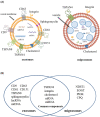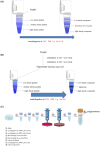Differences between migrasome, a 'new organelle', and exosome
- PMID: 37665060
- PMCID: PMC10718147
- DOI: 10.1111/jcmm.17942
Differences between migrasome, a 'new organelle', and exosome
Abstract
The migrasome is a new organelle discovered by Professor Yu Li in 2015. When cells migrate, the membranous organelles that appear at the end of the retraction fibres are migrasomes. With the migration of cells, the retraction fibres which connect migrasomes and cells finally break. The migrasomes detach from the cell and are released into the extracellular space or directly absorbed by the recipient cell. The cytoplasmic contents are first transported to the migrasome and then released from the cell through the migrasome. This release mechanism, which depends on cell migration, is named 'migracytosis'. The main components of the migrasome are extracellular vesicles after they leave the cell, which are easy to remind people of the current hot topic of exosomes. Exosomes are extracellular vesicles wrapped by the lipid bimolecular layer. With extensive research, exosomes have solved many disease problems. This review summarizes the differences between migrasomes and exosomes in size, composition, property and function, extraction method and regulation mechanism for generation and release. At the same time, it also prospects for the current hotspot of migrasomes, hoping to provide literature support for further research on the generation and release mechanism of migrasomes and their clinical application in the future.
Keywords: exosomes; extracellular vesicles; migracytosis; migrasomes; organelle.
© 2023 The Authors. Journal of Cellular and Molecular Medicine published by Foundation for Cellular and Molecular Medicine and John Wiley & Sons Ltd.
Conflict of interest statement
The authors declare that they have no competing interests.
Figures



Similar articles
-
Discovery of the migrasome, an organelle mediating release of cytoplasmic contents during cell migration.Cell Res. 2015 Jan;25(1):24-38. doi: 10.1038/cr.2014.135. Epub 2014 Oct 24. Cell Res. 2015. PMID: 25342562 Free PMC article.
-
Migrasome: a novel insight into unraveling physiological and pathological function.Mol Biol Rep. 2025 May 28;52(1):509. doi: 10.1007/s11033-025-10615-y. Mol Biol Rep. 2025. PMID: 40434508 Review.
-
Migrasome and Tetraspanins in Vascular Homeostasis: Concept, Present, and Future.Front Cell Dev Biol. 2020 Jun 16;8:438. doi: 10.3389/fcell.2020.00438. eCollection 2020. Front Cell Dev Biol. 2020. PMID: 32612990 Free PMC article. Review.
-
Migrasome, a novel organelle, differs from exosomes.Biochem Biophys Rep. 2023 Jun 9;35:101500. doi: 10.1016/j.bbrep.2023.101500. eCollection 2023 Sep. Biochem Biophys Rep. 2023. PMID: 37601457 Free PMC article. Review.
-
Research Progress and Direction of Novel Organelle-Migrasomes.Cancers (Basel). 2022 Dec 26;15(1):134. doi: 10.3390/cancers15010134. Cancers (Basel). 2022. PMID: 36612129 Free PMC article. Review.
Cited by
-
The Role of Extracellular Vesicles in Liver Fibrosis: Friends or Foes?Biomedicines. 2024 Nov 22;12(12):2665. doi: 10.3390/biomedicines12122665. Biomedicines. 2024. PMID: 39767572 Free PMC article. Review.
-
Extracellular vesicles in non-small cell lung cancer stemness and clinical applications.Front Immunol. 2024 May 3;15:1369356. doi: 10.3389/fimmu.2024.1369356. eCollection 2024. Front Immunol. 2024. PMID: 38765006 Free PMC article. Review.
-
Bacterial toxins induce non-canonical migracytosis to aggravate acute inflammation.Cell Discov. 2024 Nov 5;10(1):112. doi: 10.1038/s41421-024-00729-1. Cell Discov. 2024. PMID: 39500876 Free PMC article.
-
Beneficial and challenges of exosome application in ischemic heart disease.Stem Cell Res Ther. 2025 May 19;16(1):247. doi: 10.1186/s13287-025-04363-w. Stem Cell Res Ther. 2025. PMID: 40390086 Free PMC article. Review.
-
Migrasomes should not be classified as extracellular vesicles.J Cell Mol Med. 2024 May;28(9):e18337. doi: 10.1111/jcmm.18337. J Cell Mol Med. 2024. PMID: 38722299 Free PMC article. No abstract available.
References
-
- Jiang D, Jiang Z, Lu D, et al. Migrasomes provide regional cues for organ morphogenesis during zebrafish gastrulation. Nat Cell Biol. 2019;21(8):966‐977. - PubMed
-
- Xu R, Rai A, Chen M, Suwakulsiri W, Greening DW, Simpson RJ. Extracellular vesicles in cancer—implications for future improvements in cancer care. Nat Rev Clin Oncol. 2018;15(10):617‐638. - PubMed
Publication types
MeSH terms
Grants and funding
LinkOut - more resources
Full Text Sources

